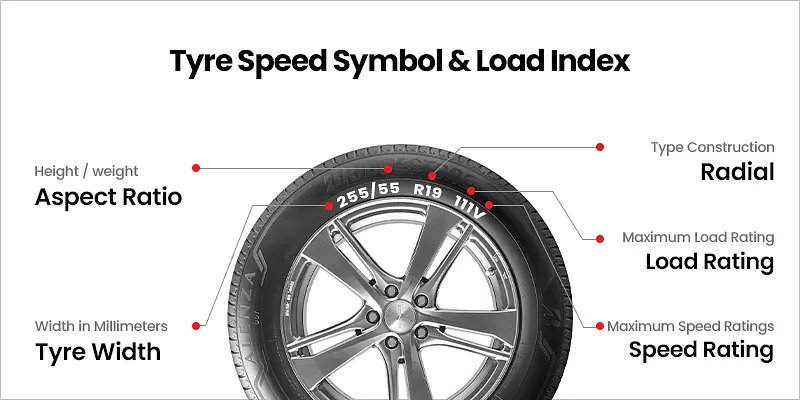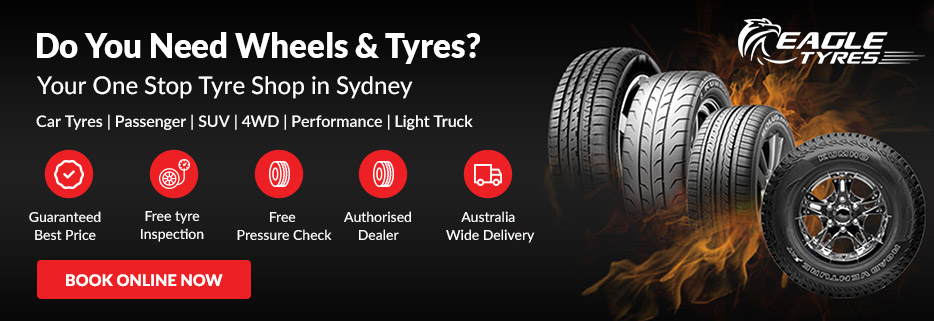
It is vital to know the speed and load limitations of your vehicle’s tyre if you use your vehicle for any of the below-mentioned purposes:
- If your car spends the majority of time off-road
- Use Ute or Light Truck to transport goods
- Use your car in high-performance settings; for instance, as a track car.
When your car exceeds the maximum suggested load or speed, your vehicle tyres won’t function at their best efficiency and put in danger your safety and the safety of your vehicle and those on the road.
How To Find Your Car Tyre’s Load Index and Speed Symbol?
Next to your car tyre’s size markings, you’ll find load index and speed symbol markings located on the sidewall.
Let’s take an illustration to understand: Assume your car tyre’s sidewall markings are 235/45R17 97W – here, the last part of the sidewall markings are ‘97W’, it stands for the load index and speed symbol. These characters are alphanumeric; they stand for:
- The number ‘97’ refers to the load index of the tyre
- The alphabet ‘W’ refers to the tyre’s speed symbol
Load Index
- The load rating, which in the above example is ‘97’, relates to the maximum weight that each tyre can hold and carry. Furthermore, this number ‘97’ stands for a load capacity of 750 kilograms. If you get a different number, you can check it online by entering search terms: “load index chart for tyres”. As per the load index chart, the higher the load index number, the higher is the weight carrying capabilities of each tyre.
- Most passenger vehicle load indexes fall between 62 to 126. People using their vehicle to transport goods or off-road drive should use a tyre with a higher load rating than those who use their cars only for the work commute.
- When replacing tyres, ensure the tyres load index matches or surpasses the value shown on the vehicle’s placard, which you can find on the petrol tank’s flap or driver’s side door or in the glove box or the owner’s manual.
Speed Symbol
Speed rating, which in the above example is ‘W’, means the maximum speed the vehicle can run on is 270 kilometres per hour. If you get a different alphabet, you can check it online by entering the terms: “speed symbol chart for tyres”. If you want to use your car in high-performance pursuits or track driving, you need to look for a tyre that can withstand high speeds. Remember that legal speed symbol requisites may vary by state.
Ply Ratings
Ply ratings help determine the load-carrying capabilities of a tyre in terms of plies. Ply rating earlier was referred to as the number of cotton layers used to fortify a tyre’s casing. Tyres are labelled as 10-ply these days, and while they provide equivalent strength of 10 individual layers of cotton, but not made from the same material. With time, steel ply and radial construction have replaced cotton, leading to a new level known as the ‘Load Range’.
Load Range determines the maximum weight you can put on a tyre horizontally, which differs per the tyre size and inflation limits. A tyre having a high ply rating makes it super immune to punctures and damage, precisely what you need when you require a tyre that can support plenty of weight or for your off-roading adventure trips. For instance, tyres of ordinary passenger cars will have a lower ply rating marking than light truck tyres with higher ply rating marking. Thus, light truck tyres are capable of off-roading or carrying heavier loads.
How To Choose The Right Load Index And Speed Symbol For My Car?
If you’re using your car for a daily work commute and take occasional weekend trips, you need to focus on finding the tyre that best suits your vehicle and your driving style without worrying about load index or speed symbol. So when should you consider load indexes and speed symbols? Well, you must consider load indexes and speed symbols when selecting the right tyre for your vehicle in the following situations:
- If you drive a performance vehicle
- Frequently use your car for off-roading
- When you use your vehicle to transport goods.
-
- High-performance: Generally, tyres that you will see on sports cars will have a higher speed symbol and lower load index in all likelihood.
- Off-roading: Off-road tyres will have a higher load index and lower speed symbol. Why? Off-road vehicle tyres will have to carry a heavier vehicle and load; thus, they will be more stressed than an average car tyre.
- Transporting Goods: Light truck drivers, couriers, tradesmen/ tradeswomen will often have to carry heavier equipment or products; thus, they will require a tyre with a higher load index for their vehicles.
Visit Eagle Tyres Today!
If you need help buying the right tyres for your car, drive your vehicle to Eagle Tyres, the Tyre Shop in Sydney, and we will help identify the best tyres and provide a professional tyre fitment. If you need more information or require any help on the go, call us on 02 9637 4355, and we will be happy to assist you.






